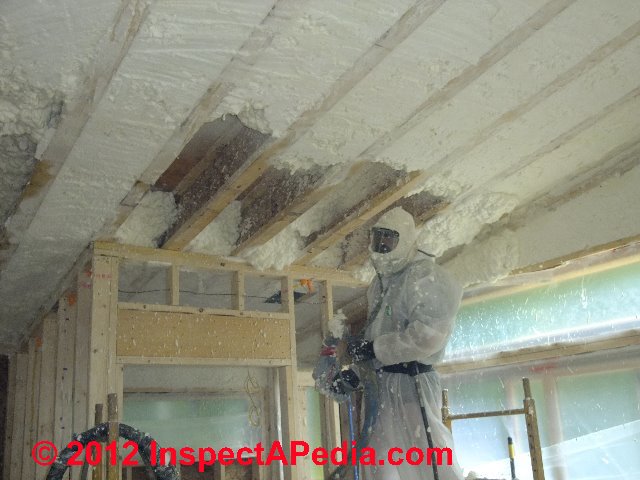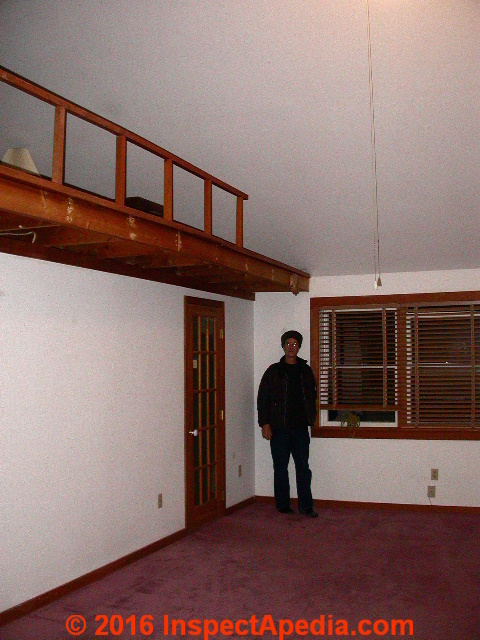 Un-vented Roof / Hot Roof FAQs-2
Un-vented Roof / Hot Roof FAQs-2
Best hot roof design if cost isn't an issue
- POST a QUESTION or COMMENT about un-vented cathedral ceiling under-roof spaces
Reader & Moderator review the risks of hot roof designs, aka dense-packed insulated sloped roofs and suggest a "best design".
Here along with reader Dave we discuss hot, un-vented roofs and what steps we might take to avoid trouble.
This article series describes various solutions for un-vented cathedral ceilings and similar under-roof spaces, offering advice on how to avoid condensation, leaks, attic mold, & structural damage when roof venting is not possible.
InspectAPedia tolerates no conflicts of interest. We have no relationship with advertisers, products, or services discussed at this website.
- Daniel Friedman, Publisher/Editor/Author - See WHO ARE WE?
Un-Vented Roof Risks & Solutions with Dave

Recently-posted questions & answers about designs for & problems in un-vented or "hot roof" designs originally given at HOT ROOF DESIGN PROBLEMS - you will enjoy reviewing the advice given there.
Photo at page top: open celled foam insulation being installed in a hot roof
Photo just above: the author (DF) below a well-ventilated cathedral roof he built in the 1970s.
If cost isn't an issue spray-foaming ceilings with closed cell foam is best
So if cost wasn't an issue and my house never had soffit vents, (there are ridge and gable vents there),
One and a half story cape cod, sloped ceilings.
I have a very reputable contractor that suggests Sprayfoam the sloped ceilings, then blown in cellulose for attic floor.
They will have the luxury of having all insulation currently in attic removed, all bedroom ceilings removed as house is being renovated.
So Sprayfoam the short exterior walls in closets (they're about 3 feet high, the slope part of ceilings, replace new drywall, then cellulose in attic.
Using closed cell.
Ps. After all old insulation has been removed in attic, they will seal all air leaks.
Does this sound okay? - On 2017-03-15 by Dave - You can reach me at davemax21@hotmail.com
Reply by (mod)
Probably, as I like the waterproof nature of closed cell foam. But I warn that ANY dense-packed or foam-insulated roof, either with closed cell or open celled foam, can become a disaster if there are leaks into the roof cavity.
That risk can be greater with closed cell foam that holds water and doesn't let it show up as a leak indoors until the roof structure has become badly rotted.
SO: what's going on your roof surface ?
Followup by Dave
Roof surface?Reply by (mod)
Yes, Dave,
You are describing a "hot roof" design - that can work and makes sense for cathedral ceiling designs, but in my experience leaks into a foamed roof structure can cause catastrophic damage before they're discovered, so it is a smart design that uses the most bullet-proof roof covering - such as standing seam metal roofing.Followup by Dave - hope that no roof leaks will occur
Metal roofing only for Sprayfoamed rafters, slopes?
Hopefully no leaks will occur but no barrier is required if Sprayfoaming the rafters or cathedrals
Reply by (mod) - a more-reliable roof is a smart idea over hot-roof installations
By no means would I claim that metal roofs are *required* by any code or standard for hot roof desings.
What I am pointing out is that now, with nearly 40 years of experience with hot roof designs, we know very well that leaks into a foamed (especially closed-cell foam) roofs are a disaster, so I want the most leak-resistant, long-lived roof covering I can get on the roof.
Leaks into a foamed hot roof or even a fiberglass insulated hot roof may not be detected until years of rot and decay have ensued.
"Hopefully no leaks will occur" is not enough to make me highly-confident in an individual roof design. Over the 20 to 40 or longer year life of a roof it is very common for leaks to occur:
Shingles crack, blow off, are damaged by foot traffic
Flashings crack, wear through, corrode
Branches fall and punch holes
Up north, ice dams lift roofing, push water and ice into the roof
Roof coverings have a demanding life.See my hot roof design detail suggestions
at HOT ROOFS vs VENTING in COLD CLIMATES
Followup by Dave
So with no soffit vents basically there should be nothing in the sloped part of the ceilings?Reply by (mod) - debating the pro's & cons of Hot Roofs: where do the risks lie
Dave: where does that claim derive?
Of course no one is saying that. Let's not be diffident.
First, soffit-vents alone won't do a thing to ventilate a roof.
Second, nobody with an ounce of sense is arguing that in heating and cooling climates the roof should be un-insulated.
See inspectapedia.com/ventilation/Roof_Ventilation_Specs.php ROOF VENTILATION SPECIFICATIONS
Perhaps what I've not made clear is that leaks into a sealed, un-vented roof cavity is more pernicious than leaks into a vented cavity
- may not appear visible at all to building occupants - from the inside water passage is blocked by solid foam insulation or by plastic vapor barriers (the latter can hide leaks in a vented cavity too)
- water is trapped in the un-vented roof cavity - it doesn't dry out for months or longer - like the Hotel California, water can check in, but it can (almost) never leave
- wet building materials invite rot, insect attack, mold contamination - all costly problemsFollowup by Dave
Sorry but the diagram keeps getting deleted .
It's:
I.stack.imgur.com/0tHCk.jph
Click on link shows my second floor, easier without the small knee walls
Just a technical note, this is a small house, only 900 square feet. Has a ridge vent, and gable vents.
Meant what is one to do?
No not being difficult , just gets frustrating cause I really don't want to put in soffit vents but want a warmer ceiling. What does one with existing roof shingles only 10 years old and assumed they never leaked
Your articles makes sense, vents need to draw.
Great article, we need to go with the unvented though
Reply by (mod) - A hot roof design can work, but has the risks we've suggested.
Yep.
So a hot roof design can work, but has the risks we've suggested. And a vented roof doesn't vent unless the vents are properly sized, located, and un-blocked.
Improper venting increases heating and cooling costs and can also invite its own moisture problems.
Our expert Steven Bliss commented to offer a final word on Hot Roof Designs:
I agree with you that, in the real world, this is not such a good idea. If there's a flashing leak or other roof leak, you could have a pretty soggy mess that stays wet for a long time and could cause structural decay.
Plenty of people are building hot roofs, but I wouldn't -- except maybe one with spray urethane which won't absorb much water like cellulose would.
If you need to go un-vented, do all you can to bulllet-proof the installation.
See our summary of the difference between the ideal and what actually happens in "real life" at
CONCLUSIONS & RECOMMENDATIONS for HOT ROOFS
...
Continue reading at HOT ROOF DESIGN PROBLEMS or select a topic from the closely-related articles below, or see the complete ARTICLE INDEX.
Or see HOT ROOF UN-VENTED ROOF FAQs-3 - more-recently posted questionsand answers about un-vented roofs and cathedral ceiling ventilation - or not.
Or see this
Article Series Contents
- CATHEDRAL CEILING VENTILATION
- HOT ROOF DESIGN PROBLEMS
- HOT UN-VENTED ROOF DESIGN SOLUTIONS
- HARD to VENT ROOF SOLUTIONS for HIPS & CATHEDRAL CEILINGS
- PROBLEMS with PARTIAL ROOF VENTILATION
- ROOF VENTILATION SPECIFICATIONS pros and cons of hot roof designs
Suggested citation for this web page
HOT ROOF UN-VENTED ROOF FAQs-2 at InspectApedia.com - online encyclopedia of building & environmental inspection, testing, diagnosis, repair, & problem prevention advice.
Or see this
INDEX to RELATED ARTICLES: ARTICLE INDEX to BUILDING VENTILATION
Or use the SEARCH BOX found below to Ask a Question or Search InspectApedia
Ask a Question or Search InspectApedia
Try the search box just below, or if you prefer, post a question or comment in the Comments box below and we will respond promptly.
Search the InspectApedia website
Note: appearance of your Comment below may be delayed: if your comment contains an image, photograph, web link, or text that looks to the software as if it might be a web link, your posting will appear after it has been approved by a moderator. Apologies for the delay.
Only one image can be added per comment but you can post as many comments, and therefore images, as you like.
You will not receive a notification when a response to your question has been posted.
Please bookmark this page to make it easy for you to check back for our response.
IF above you see "Comment Form is loading comments..." then COMMENT BOX - countable.ca / bawkbox.com IS NOT WORKING.
In any case you are welcome to send an email directly to us at InspectApedia.com at editor@inspectApedia.com
We'll reply to you directly. Please help us help you by noting, in your email, the URL of the InspectApedia page where you wanted to comment.
Citations & References
In addition to any citations in the article above, a full list is available on request.
- In addition to citations & references found in this article, see the research citations given at the end of the related articles found at our suggested
CONTINUE READING or RECOMMENDED ARTICLES.
- Carson, Dunlop & Associates Ltd., 120 Carlton Street Suite 407, Toronto ON M5A 4K2. Tel: (416) 964-9415 1-800-268-7070 Email: info@carsondunlop.com. Alan Carson is a past president of ASHI, the American Society of Home Inspectors.
Thanks to Alan Carson and Bob Dunlop, for permission for InspectAPedia to use text excerpts from The HOME REFERENCE BOOK - the Encyclopedia of Homes and to use illustrations from The ILLUSTRATED HOME .
Carson Dunlop Associates provides extensive home inspection education and report writing material. In gratitude we provide links to tsome Carson Dunlop Associates products and services.

